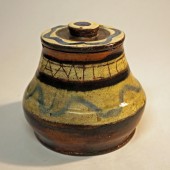![]() Printer version
Printer version
Henry Varnum Poor
1887 Born Chapman, Kansas
1970 Died Crow House Rockland, New York
EDUCATION
—Painting, Slade School, London, England
—Painting, Academie Julien, Paris, France
1910 BA Stanford University, Palo Alto, California
PRIMARY WORK EXPERIENCE
1911-1912Stanford University, Palo Alto, California
1920-1970 Studio Potter
BIOGRAPHY
Henry Varnum Poor is best known for his thrown earthenware domestic work especially plates and bowls which were glazed with metallic oxides on slip, often with the addition of sgraffito.
Still lifes, pastoral scenes, portraits, and figures were his subjects and reflected his training as a post-impressionist painter. He also created many painted and tiled murals in public buildings including the Departments of Justice and the Interior in Washington, DC.
After returning from World War I, Poor traveled to NYC to sell his paintings. During that time he was introduced to ceramics which became his creative focus from the 1920s onward. Poor is considered one of the first studio potters in the USA. His lifestyle embodied the Studio Crafts Movement. Poor lived and worked for over 50 years at Crow House where he designed and built his home, studio and out buildings.
Poor was one of four founders and the first president of the Skowhegan School of Painting and Sculpture in Madison, Maine.
PUBLIC COLLECTIONS
The Art Institute of Chicago, Chicago, Illinois
Brooklyn Museum, New York, New York
Metropolitan Museum of Art, New Yor, New York
The Museum of Arts and Design, New York, New York
The Museum of Fine Arts, Houston, Texas
Newark Museum, Newark, New Jersey
Wichita Art Museum, Wichita, Kansas
BIBLIOGRAPHY
Clark, Garth and Margie Hughto. A Century of Ceramics in the United States: A Study of It’s Development. Syracuse, NY: Everson Museum with E.P. Dutton and Co. Inc., 1979.
Levin, Elaine. The History of American Ceramics: From Pipkins and Bean Pots to Contemporary Forms. New York, NY: Harry N. Abrams Inc., Publishers, 1988.
Poor, Henry Varnum. A Book of Pottery: From Mud into Immorality. New York, NY: Prentice Hall, Inc., 1958.
Stiegleder, Linda. “Henry Varnum Poor 1887-1970.” American Craft 44, no. 1 (February/March 1984).
Henry Varnum Poor’s ceramics are typically signed with a linked HVP in which the center V is formed by the right vertical of the H and the vertical of the P angled downward and joined to form the V. Poor adopted this linked HVP mark in the mid to late 1920's, and used it on all his ceramics going forward. In his earlier career he sometimes signed with a straight "HP" in color on the face of the work. He signed his paintings "HV Poor". (Peter Poor, son of Henry Varnum Poor, 3/10/2017)
Method: Slab-Built, Hand-Built
Surface Technique: Brushwork, Incised, Overglaze (On Glaze), Underglaze
Method: Thrown
Dimensions: H. 4.63 x 5.25 inches in diameterSurface Technique: Glaze
Citation: "The Marks Project." Last modified August 27, 2025. http://www.themarksproject.org:443/marks/poor
















